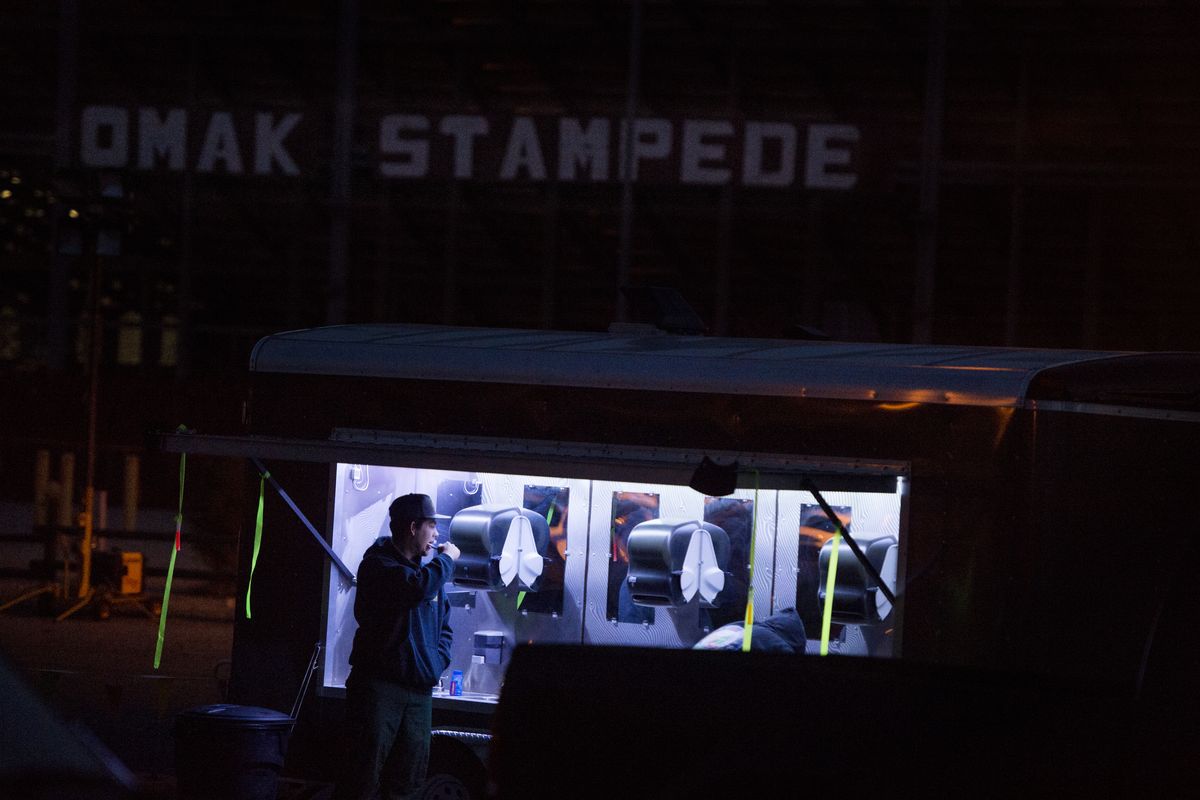Firefighters’ camp a small city

OMAK, Wash. – Mike McCann is used to pitching his tent among hundreds of others in a field.
He’s used to waiting in line for dinner and a shower after a 14-hour day of firefighting, falling asleep to the drone of generators.
But sometimes, little things get under his skin. Like a Porta Potty door slamming at 4 a.m. when he’s trying to get that last 45 minutes of shut-eye.
“When you have to get up at 4:45, it’s nearly impossible to go back to sleep,” explained McCann, a fire engine crew boss from Medford, Oregon.
Welcome to life in a fire camp.
About 30,000 men and women are fighting fires across the West this summer. Most work 14 days straight, followed by a 48-hour break. They travel from wildfire to wildfire, staying at tent-and-trailer cities that spring up overnight.
Privacy is hard to find at fire camp, but there’s an easy camaraderie forged from the shared experience of working a physically demanding, sometimes dangerous job.
After weeks on the fire line, crew members relate like siblings. Firefighting agencies follow the same organizational structure, which allows crews from all over the country to work together seamlessly.
“There are only so many people in the U.S. who do this,” said Donnie Davis, a public information officer for the North Star fire. “You’re closer to the fire crew than you are your own family.”
With the large fires burning in north-central Washington, several thousand firefighters are stationed in camps in Omak and nearby communities. Ralph Malone is the administrator for the city of Omak, population 4,792. He doesn’t hear any complaints. Local residents are grateful for the influx of men and women in yellow Nomex shirts.
“In times like this, when you have wildfires all around, firefighting is the primary endeavor of the community,” Malone said.
About 800 firefighters are stationed at the Omak Stampede grounds, which is the incident command base for the North Star and Tunk Block fires burning east of town. Despite cooler temperatures and rain showers, the fires are expected to burn until mid-October.
The camp is a city unto itself. From the top of the Omak Stampede’s grandstand, Phil Pillett – a New York City firefighter who’s the camp’s facilities unit leader – explains the layout like an urban planner.
Offices are housed in a dozen white tents on either side of a “main street.” There’s a plaza that provides firefighters easy access to food trailers, eating areas and showers. Sleeping areas are set up away from roads and generators, but the generators’ low rumble permeates camp.
“They tell us where they want us and we build the camp,” Pillett said.
The planning starts with a GoogleEarth view of the site, usually while Pillet is en route to the area.
“Fire camps get put together on such short notice, and they take care of a whole bunch of people,” said Alex Robertson, the North Star fire’s operations section chief. But the generators’ location is always a discussion topic, he said. In this camp, the generators are adjacent to his tent office and drown out conversations.
Robertson, 44, has been a wildland firefighter since 1991. He misses his wife and two children during fire season, and the comfort of sleeping in his own bed. But he thrives on the fast-paced work and the rapport with others on the incident command team.
“They’re like a second family,” he said.
Larry Redfield and Darrin Shaw arrived at the North Star fire from Central Pierce County Fire and Rescue. They’ve worked together for 20 years and felt lucky to be assigned to the same engine crew.
“We hardly have to communicate,” Shaw said. “You understand how the other person thinks.”
Their engine is known as a “Pavement Princess” in camp – it’s not designed for off-road travel. They’re providing assistance to wildland crews protecting structures. “We’re the third-string,” Redfield joked.
McCann, the engine crew boss, pulled into the North Star camp late one afternoon last week. He and his four crew members had driven 600 miles from the Siskiyou National Forest in Medford.
The weary crew lined up for dinner, stopping at the hand-washing station outside the eating area. No one wants to get “camp crud” – the fast-spreading colds and coughs.
Dinner was 14 ounces of barbecued ribs, an enchilada, a mound of au gratin potatoes and green beans. Firefighters consume 5,000 to 6,000 calories a day.
“They take good care of us,” said Morgan Voss, 24, who finished everything on her plate except the beans. She’s working her first fire season.
McCann, a 15-year veteran with a gray streak in his beard, is the senior member of the crew. The others are in their 20s. They like working in the woods and the pay that accrues with the long hours.
Firefighting is putting Jeremy Korn, 23, through Oregon State University without student loans. Most years, Korn – a natural resources major – earns enough to cover his tuition costs.
Firefighting pay varies by agency, job, region and experience level. For a beginning firefighter on a Forest Service engine crew in the Northwest, hourly wages start at roughly $12, but jump to $18 for overtime.
After dinner, there was the routine of settling into a new camp. Crew members crawled into their sleeping bags around 9:30 p.m.
Morning would come quickly, with breakfast, engine checks and a 6 a.m. fire briefing. Then they’d head out for a 12- to 14-hour workday.
Engine crews are the multitaskers of wildland fires. They could be building fire lines, laying out hose, mopping up burned areas or protecting rural homes.
“It’s honorable work,” McCann said.